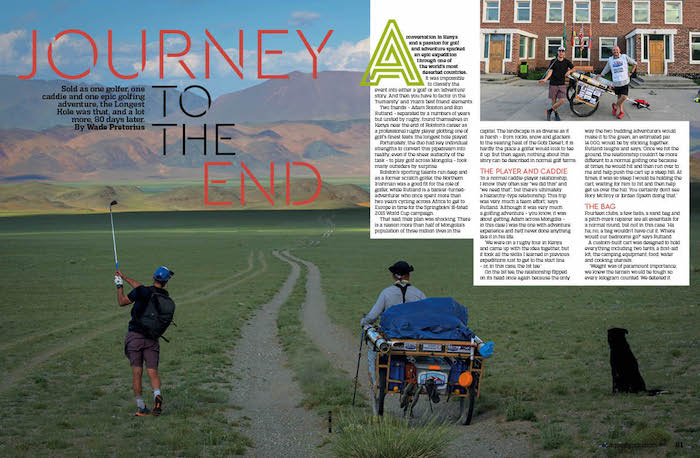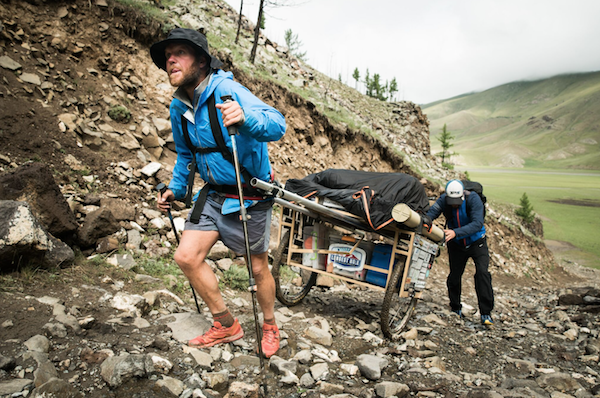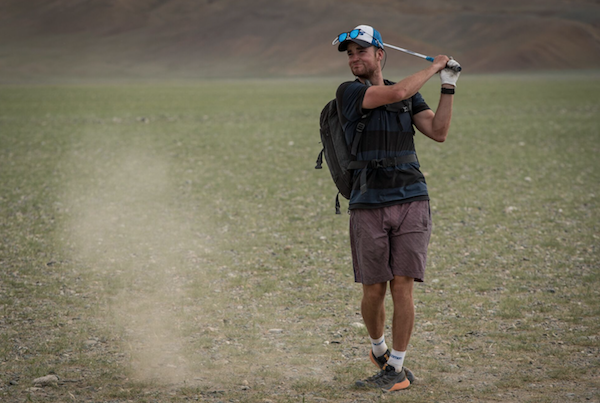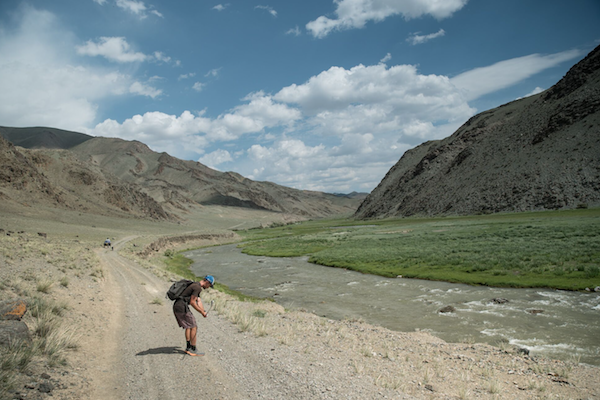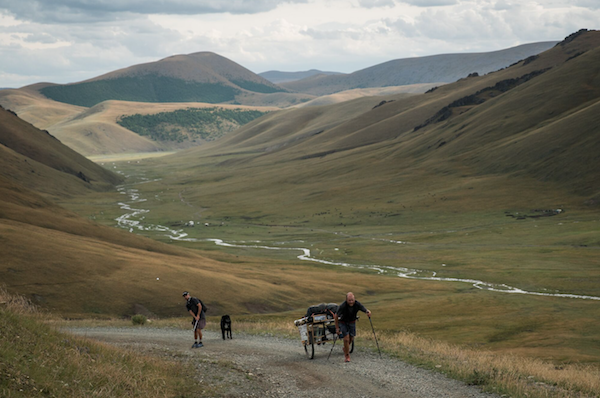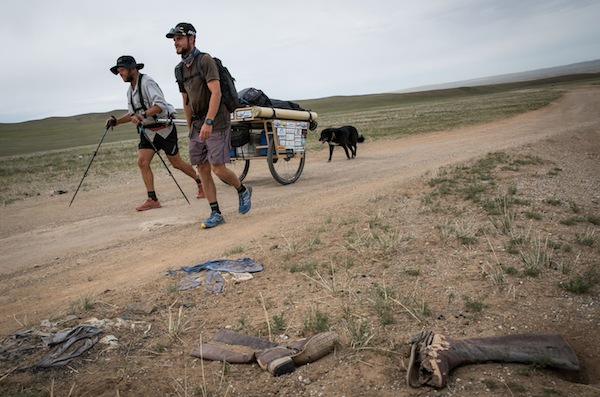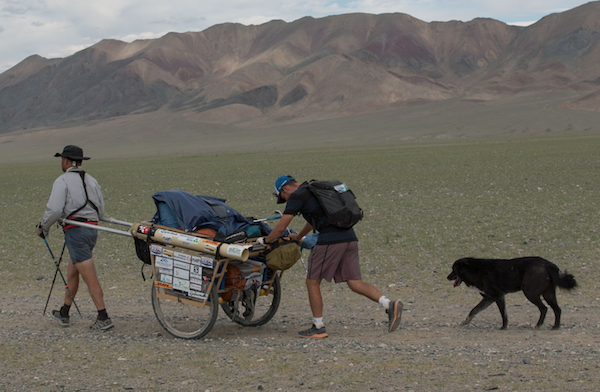Sold as one golfer, one caddie and one epic golfing adventure, the Longest Hole was just that, and a lot more, 80 days later, writes WADE PRETORIUS in Compleat Golfer.
A conversation in Kenya combined with a passion for golf and adventure sparked an epic expedition through one of the world’s most deserted countries. It was impossible to classify the event into either a ‘golf’ or an ‘adventure’ story.
And then you have to factor in the ‘humanity’ and ‘man’s best friend’ elements. Two friends – Adam Rolston and Ron Rutland – separated by a numbers of years but united by rugby, found themselves in Kenya near the end of the former’s professional rugby career plotting one of golf’s finest feats: the longest hole played. Fortunately, the duo had key individual strengths to convert this pipedream into reality, even if the sheer audacity of the task – to play golf across Mongolia – took many outsiders by surprise.
Rolston’s sporting talents run deep and as a former scratch golfer, the Northern Irishman was a good fit for the role of golfer, while Rutland is a banker-turned-adventurer who once spent more than two years cycling across Africa to get to Europe in time for the Springboks’ ill-fated 2015 World Cup campaign.
That said, their plan was shocking.
There is a reason more than half of Mongolia’s population of three million lives in the capital. The landscape is as diverse as it is harsh – from rocks, snow and glaciers to the searing heat of the Gobi Desert, it is hardly the place a golfer would look to tee it up.
But then again, nothing about this story can be described in normal golf terms.
The player and caddie
‘In a normal caddie-player relationship, I know they often say “we did this” and “we need that”, but there’s ultimately a hierarchy-type relationship. This trip was very much a team effort,’ says Rutland. ‘Although it was very much a golfing adventure – you know, it was about getting Adam across Mongolia – in this case I was the one with adventure experience and he’d never done anything like it in his life.
‘We were on a rugby tour in Kenya and came up with the idea together, but it took all the skills I learned in previous expeditions just to get to the start line – or, in this case, the 1st tee.’
On the 1st tee, the relationship flipped on its head once again because the only way the two budding adventurers would make it to the green, an estimated par 14 000, would be by sticking together. Rutland laughs and says, ‘Once we hit the ground, the relationship couldn’t be more different to a normal golfing one because at times, he would hit and then run over to me and help push the cart up a steep hill. At times, it was so steep I would be holding the cart, waiting for him to hit and then help get us over the hill. You certainly don’t see Rory McIlroy or Jordan Spieth doing that.’
The bag
Fourteen clubs, a few balls, a sand bag and a pitch-mark repairer are all essentials for a normal round, but not in this case. ‘Ha ha; no, a bag wouldn’t have cut it. Where would our bedrooms go?’ says Rutland. A custom-built cart was designed to hold everything including two tents, a first-aid kit, the camping equipment, food, water and cooking utensils.‘Weight was of paramount importance; we knew the terrain would be tough so every kilogram counted. We debated it and decided the extra tent was the way to go – it turned out to be a good call because we needed some space after spending so much time together in trying conditions.’ From a golfing perspective, Rolston had a driver, a 3-wood, a 4-iron, a 7-iron, an 8-iron, a wedge and a putter. ‘The driver was hit once – off the 1st tee – and the 3-wood probably twice, the 4-iron a dozen times and the putter only on the green. My biggest fear was that we’d go all the way across Mongolia and Adam would chip in. Imagine what a waste it would have been carrying that 600g, or whatever it is, all that way and never using it.’
The course
Rutland spent some time in Mongolia 10 years ago and while Rolston thought it might be good, and a lot easier, to play across his homeland, the Asian country was decided as the perfect place. Not only because of the dramatic conditions, but also due to its barren plains.
‘It’s the land of no fences. Can you imagine trying to do this across South Africa? How many farms and fences you would come across and how many permits you would require?’ says Rutland. A major obstacle was getting the timing right.
‘Ulaanbaatar is the coldest capital city in the world and we only had a four-month window. And with visas, etc, we set up a very tight schedule. We got some tips for our route because we needed a path that was physically possible, even if many thought it was crazy to do it in a country with such temperature extremes, and that’s before you factor in the mountain passes and grass plains.’
The 1st tee
It took the duo two and a half days to get to the first tee, at Khuiten Peak. ‘We looked for the most western point of the country.
‘Dozens of people told us we were mad or crazy, with comments ranging from “That’s impossible” to “Do you not have anything better to do?”’ says Rolston. ‘That first week was the hardest of my life. To get to the 1st tee we had to take a Russian jeep through a national park for five hours. From there, it was ridiculous.’
Eventually, Adam and Ron set up their European Tour tee markers, Ron put on his custom-made caddie bib and passed Adam the driver. There would be no turning back.
The round
The Longest Hole was backed by the European Tour, the Sunshine Tour and the Mongolian Golf Association, and was played in the true spirit of the game.
‘Of course we wanted to set the world record, but we also felt the strong urge to play in the spirit of the game. We took our drops, our unplayables and the like, and that added to the score.’
An app recorded every shot, with users worldwide following the progress online and being notified when the ball was in play.
‘It’s a game of honour and we appreciate that. At times it would’ve been easier to walk a few hundred metres and carry on around an area that was unplayable, but that’s not right.
‘We watched as the ball bounced around rock gardens and, at times, Adam was just hacking away trying to advance the ball. His pitching-wedge – which he unfortunately lost a few days before the finish – had lost its ‘P’ and grooves after being used to batter us towards the finish.’
Being alone, with hardly any human contact for days, there were more than a few hairy moments.
‘Our planning was pretty good but we had some interesting times. Water was a big concern – in the desert it’s life and death if you don’t have any. Once, we had only a day’s water left but out of nowhere a shepherd appeared and we managed to communicate enough for him to give us directions to a well. We threw out what we had left and filled up from the new source. We tasted it and it was instant regret. It was saline water and disgusting – it tasted like animal hair.’
The halfway house
‘The longest we’d go without seeing a settlement or people was five or six days, so we had to make sure we always had enough food and water for that time. We also sent supplies ahead of us, so it was more manageable to carry everything,’ explains Rutland, a vegatarian in a land that fills its stomach on meat and cheese.
‘To be a vegetarian in Mongolia was not easy. Fortunately for our planning, Adam’s girlfriend is a vegan, so he’s used to not eating a lot of meat.’
The pair survived on a $3-a-bag dehydrated food product in one flavour only – Louisiana beans and rice.
‘It has loads of calories, which is good, and is fairly balanced, but far from ideal when you are walking the distances we were.’
A far cry from the local golf favourites of bacon-and-egg breakfasts and the pie and gravy at your local course.
The final stretch
The journey attracted substantial media interest, with local TV stations picking up on the pair’s travels, which meant there was a fairly large crowd, including the chairman of the country’s golf board, waiting for the finish at Mt Bogd Golf Club, the only established club in the country.
‘Quite a few of Adam’s family members and friends met up with us and walked the last 15km. It was incredibly emotional, maybe more so because he’d never been so far out of his comfort zone,’ says Rutland.
‘The area before the course was really rough and eventually Adam hacked it on the club’s 18th fairway and then hit his approach to 40 feet. For three weeks, Adam was stressing about three-putting on the last. And when we got there and the crowd swelled, the pressure was on. His first putt flew by and he left himself about eight foot and downhill.’ Fortunately, Rolston boxed the putt, prompting a ‘Tiger Woods-like fist pump’ as the pair embraced with the journey completed.
The 19th hole
With just four days off during the trek, Rutland admits it will be a little while before his next adventure.
‘It was the hardest thing I’ve done in my life. Pulling a cart for seven hours a day in those conditions… it almost broke me.’
But like anyone infected by the bug, he knows a new adventure awaits. And for Rolston, who was some 6 000 shots over par, his love for golf has not been diminished one bit and he’s ready to carry on playing and working his way back to scratch.
‘AT THIS RATE, HE’S GOING TO MAKE IT TO ULAANBAATAR’
A stray dog became almost as famous as Rolston and Rutland after joining the pair fairly early in the journey.
‘We were often asked online “How are you guys? But more importantly, how’s UB?”’ laughs Ron.
After some early friction, the pair decided to keep the dog and named him ‘UB’ after the final destination.
‘He made his home under the cart and followed us everywhere. I had to carry his water, so it was Adam’s job to feed him. He became very protective of us and would nip at anyone who came too close to the cart.’
Rutland had never owned a dog, but UB quickly worked his way into his heart, with the hardened adventurer brought to tears when recounting how they parted.
‘He was a companion and ja, it was so hard saying goodbye. We left him with a lovely couple in a national park and it was good to know he’ll be happy.’
THE NUMBERS
2 011km – The total distance covered
1 800 – The number of kilometres travelled by UB
20 093 – The total number of strokes played
20 000 – The amount, in US dollars, raised for the SA Golf Development Board and Laureus Sport for Good
80 – The number of days Rolston and Rutland spent playing the hole
135 – The total number of balls lost on the trip
250 – The total number of shots played per day
6 093 – Rolston’s score over par
10 000 – The amount paid for Rolston’s 8-iron, in rands
– This article first appeared in the December issue of Compleat Golfer
Photos: Andrew King


